Comprehensive Analysis of ASOS's Supply Chain Management Strategies
VerifiedAdded on 2022/12/23
|11
|3418
|1
Report
AI Summary
This report provides a comprehensive analysis of ASOS's supply chain management. It begins with an introduction to the importance of supply chain management in the context of ASOS, a multinational online fashion retailer. The main body delves into key aspects, including customer service and inventory management, examining ASOS's approaches to handling customer inquiries and optimizing inventory levels using techniques like EOQ and minimum order quantity. The report then explores ASOS's transportation strategies, warehousing and capacity management, and the company's competitive advantages, evaluated through VRIO analysis. Critical issues, such as a lack of coordination and collaboration within the supply chain, are identified, along with potential responses to these challenges. The report concludes with findings, suggestions, and a summary of the key takeaways, offering insights into how ASOS manages its supply chain to achieve operational efficiency, customer satisfaction, and a competitive edge in the online retail market.
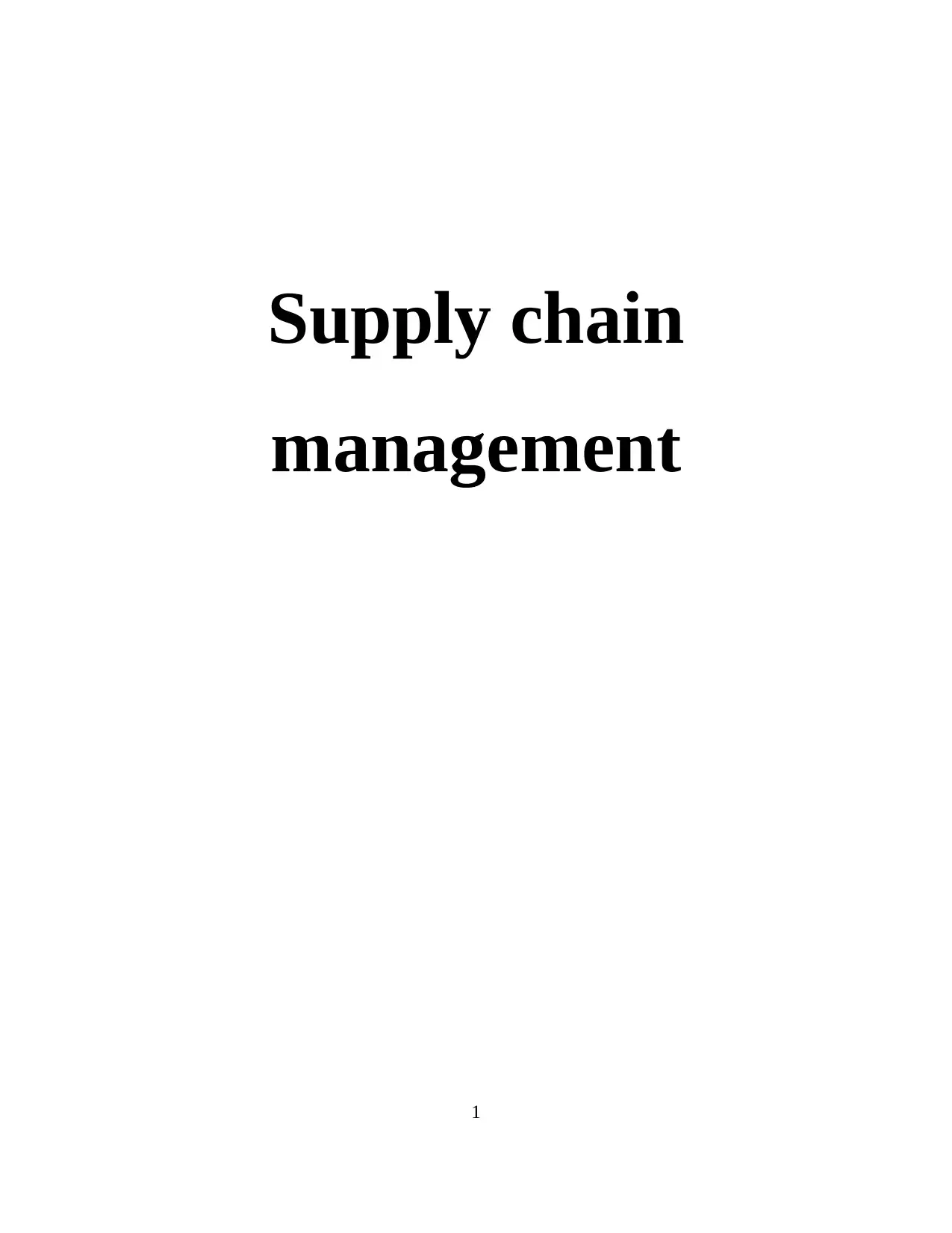
Supply chain
management
1
management
1
Paraphrase This Document
Need a fresh take? Get an instant paraphrase of this document with our AI Paraphraser
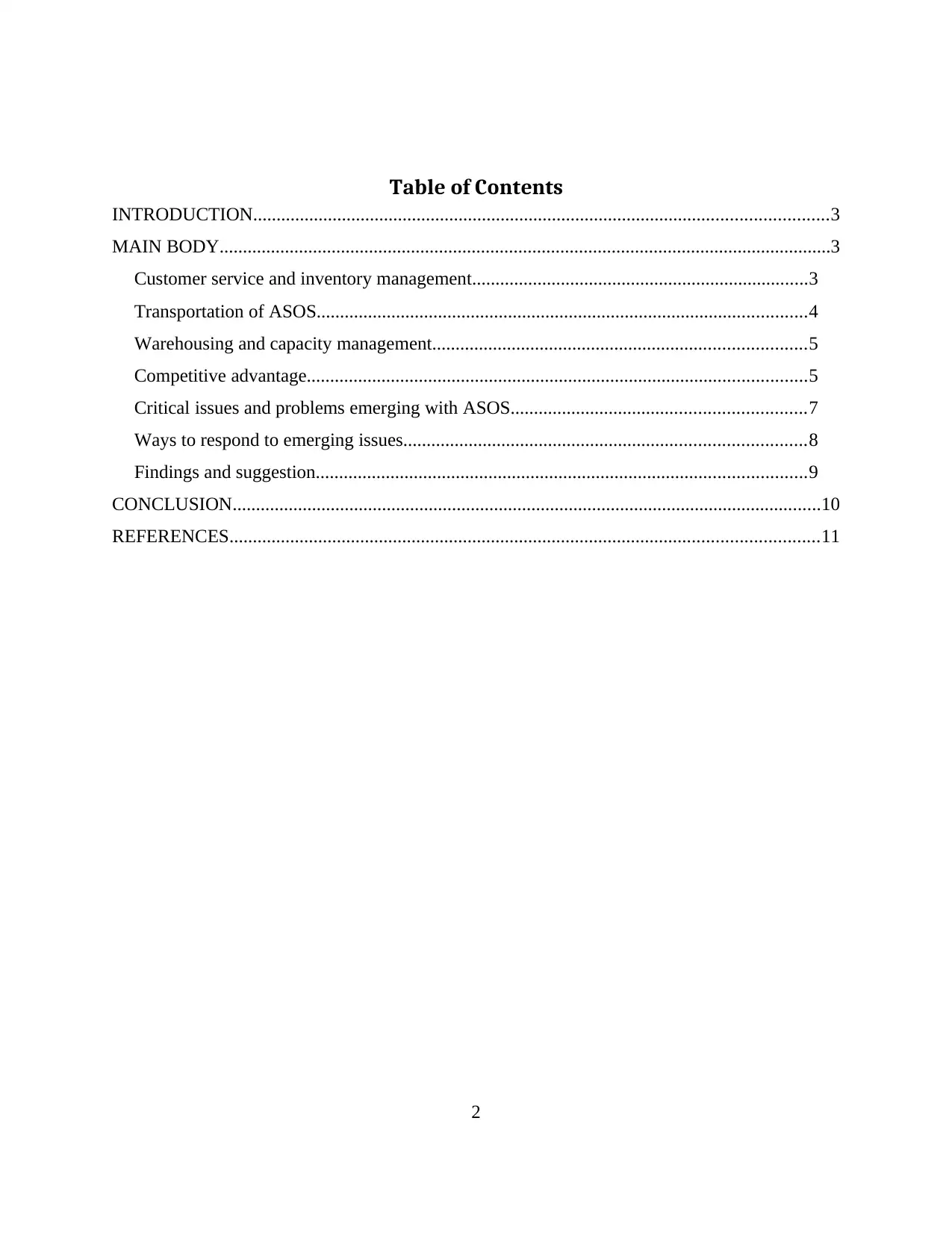
Table of Contents
INTRODUCTION...........................................................................................................................3
MAIN BODY...................................................................................................................................3
Customer service and inventory management........................................................................3
Transportation of ASOS.........................................................................................................4
Warehousing and capacity management................................................................................5
Competitive advantage...........................................................................................................5
Critical issues and problems emerging with ASOS...............................................................7
Ways to respond to emerging issues......................................................................................8
Findings and suggestion.........................................................................................................9
CONCLUSION..............................................................................................................................10
REFERENCES..............................................................................................................................11
2
INTRODUCTION...........................................................................................................................3
MAIN BODY...................................................................................................................................3
Customer service and inventory management........................................................................3
Transportation of ASOS.........................................................................................................4
Warehousing and capacity management................................................................................5
Competitive advantage...........................................................................................................5
Critical issues and problems emerging with ASOS...............................................................7
Ways to respond to emerging issues......................................................................................8
Findings and suggestion.........................................................................................................9
CONCLUSION..............................................................................................................................10
REFERENCES..............................................................................................................................11
2
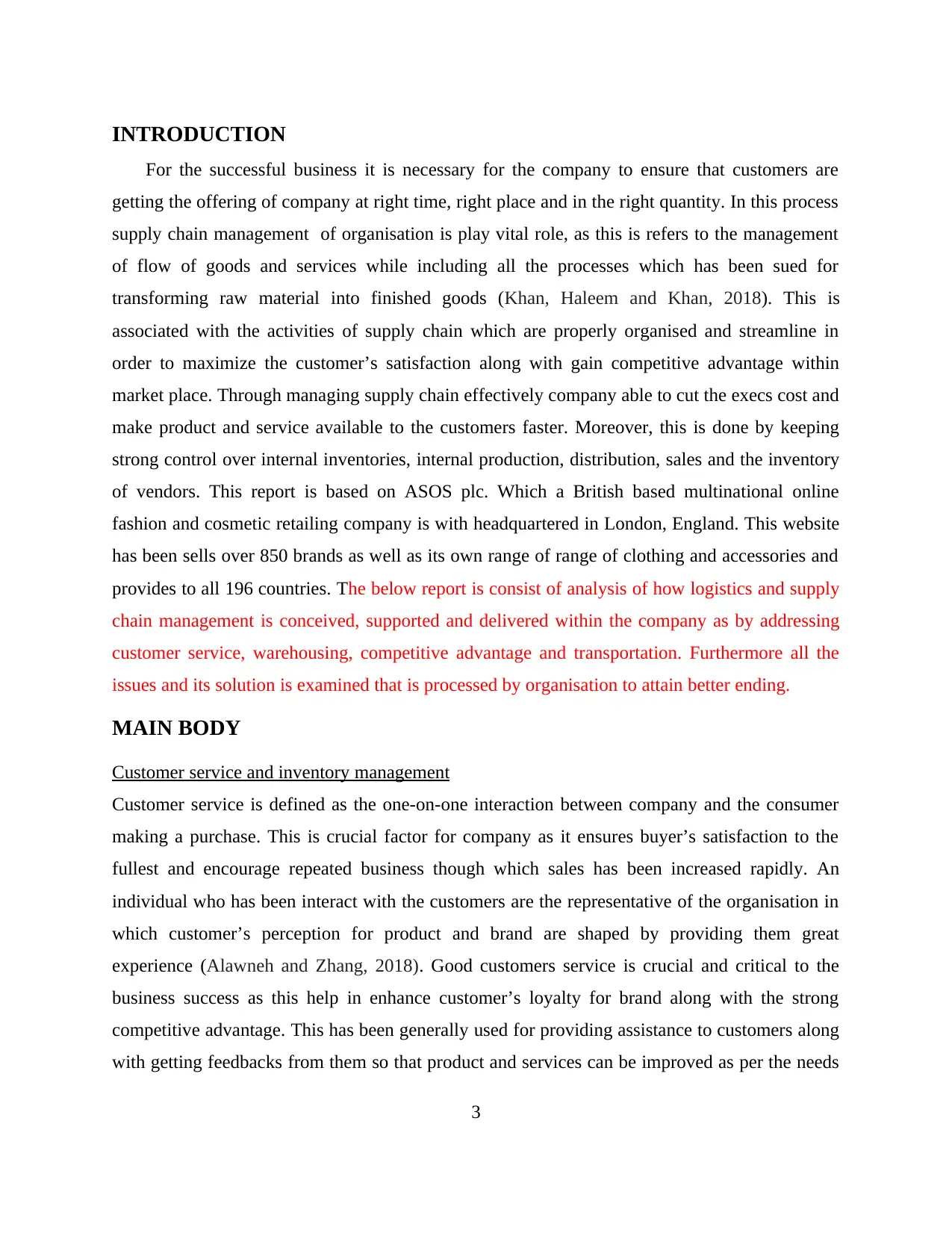
INTRODUCTION
For the successful business it is necessary for the company to ensure that customers are
getting the offering of company at right time, right place and in the right quantity. In this process
supply chain management of organisation is play vital role, as this is refers to the management
of flow of goods and services while including all the processes which has been sued for
transforming raw material into finished goods (Khan, Haleem and Khan, 2018). This is
associated with the activities of supply chain which are properly organised and streamline in
order to maximize the customer’s satisfaction along with gain competitive advantage within
market place. Through managing supply chain effectively company able to cut the execs cost and
make product and service available to the customers faster. Moreover, this is done by keeping
strong control over internal inventories, internal production, distribution, sales and the inventory
of vendors. This report is based on ASOS plc. Which a British based multinational online
fashion and cosmetic retailing company is with headquartered in London, England. This website
has been sells over 850 brands as well as its own range of range of clothing and accessories and
provides to all 196 countries. The below report is consist of analysis of how logistics and supply
chain management is conceived, supported and delivered within the company as by addressing
customer service, warehousing, competitive advantage and transportation. Furthermore all the
issues and its solution is examined that is processed by organisation to attain better ending.
MAIN BODY
Customer service and inventory management
Customer service is defined as the one-on-one interaction between company and the consumer
making a purchase. This is crucial factor for company as it ensures buyer’s satisfaction to the
fullest and encourage repeated business though which sales has been increased rapidly. An
individual who has been interact with the customers are the representative of the organisation in
which customer’s perception for product and brand are shaped by providing them great
experience (Alawneh and Zhang, 2018). Good customers service is crucial and critical to the
business success as this help in enhance customer’s loyalty for brand along with the strong
competitive advantage. This has been generally used for providing assistance to customers along
with getting feedbacks from them so that product and services can be improved as per the needs
3
For the successful business it is necessary for the company to ensure that customers are
getting the offering of company at right time, right place and in the right quantity. In this process
supply chain management of organisation is play vital role, as this is refers to the management
of flow of goods and services while including all the processes which has been sued for
transforming raw material into finished goods (Khan, Haleem and Khan, 2018). This is
associated with the activities of supply chain which are properly organised and streamline in
order to maximize the customer’s satisfaction along with gain competitive advantage within
market place. Through managing supply chain effectively company able to cut the execs cost and
make product and service available to the customers faster. Moreover, this is done by keeping
strong control over internal inventories, internal production, distribution, sales and the inventory
of vendors. This report is based on ASOS plc. Which a British based multinational online
fashion and cosmetic retailing company is with headquartered in London, England. This website
has been sells over 850 brands as well as its own range of range of clothing and accessories and
provides to all 196 countries. The below report is consist of analysis of how logistics and supply
chain management is conceived, supported and delivered within the company as by addressing
customer service, warehousing, competitive advantage and transportation. Furthermore all the
issues and its solution is examined that is processed by organisation to attain better ending.
MAIN BODY
Customer service and inventory management
Customer service is defined as the one-on-one interaction between company and the consumer
making a purchase. This is crucial factor for company as it ensures buyer’s satisfaction to the
fullest and encourage repeated business though which sales has been increased rapidly. An
individual who has been interact with the customers are the representative of the organisation in
which customer’s perception for product and brand are shaped by providing them great
experience (Alawneh and Zhang, 2018). Good customers service is crucial and critical to the
business success as this help in enhance customer’s loyalty for brand along with the strong
competitive advantage. This has been generally used for providing assistance to customers along
with getting feedbacks from them so that product and services can be improved as per the needs
3
⊘ This is a preview!⊘
Do you want full access?
Subscribe today to unlock all pages.

Trusted by 1+ million students worldwide
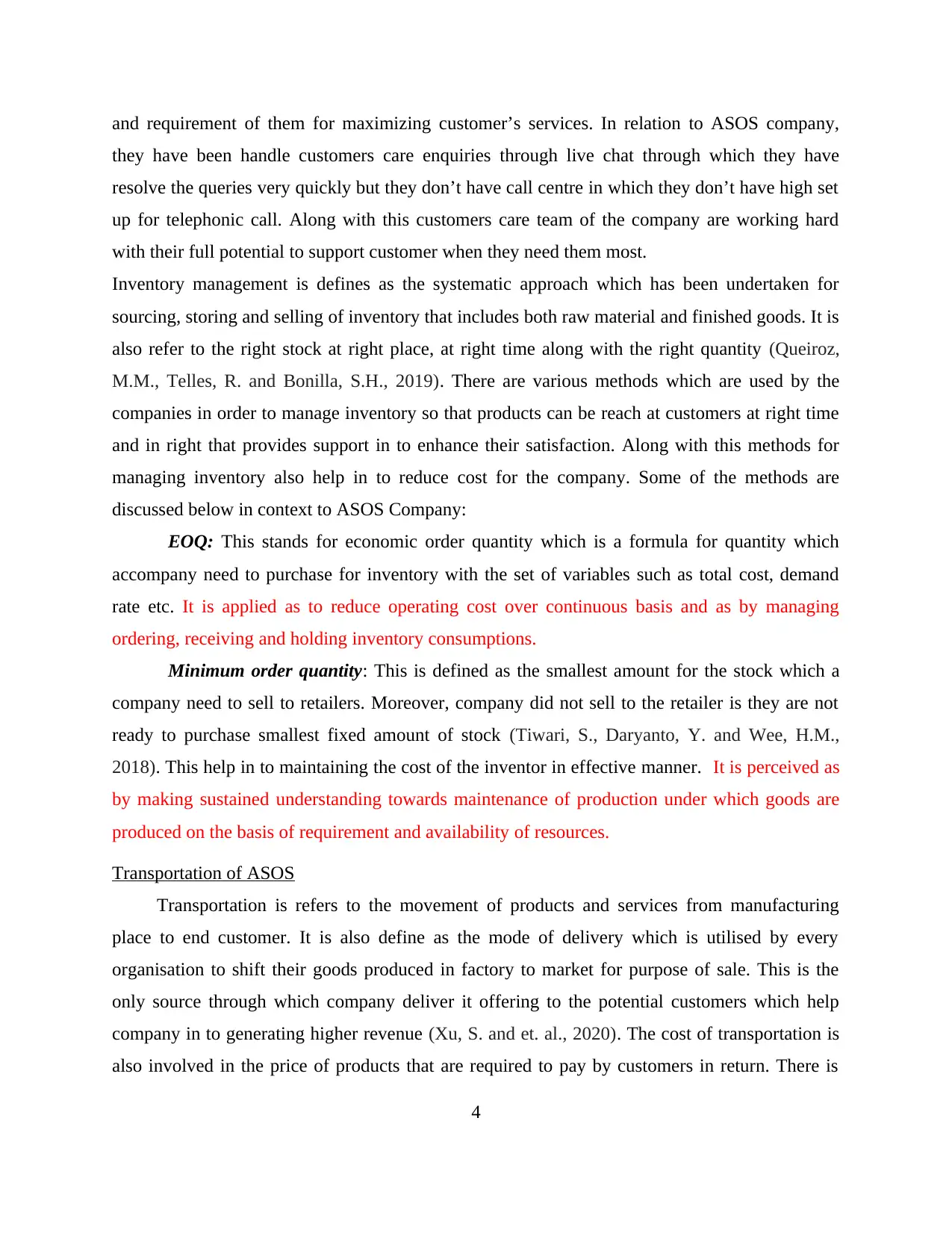
and requirement of them for maximizing customer’s services. In relation to ASOS company,
they have been handle customers care enquiries through live chat through which they have
resolve the queries very quickly but they don’t have call centre in which they don’t have high set
up for telephonic call. Along with this customers care team of the company are working hard
with their full potential to support customer when they need them most.
Inventory management is defines as the systematic approach which has been undertaken for
sourcing, storing and selling of inventory that includes both raw material and finished goods. It is
also refer to the right stock at right place, at right time along with the right quantity (Queiroz,
M.M., Telles, R. and Bonilla, S.H., 2019). There are various methods which are used by the
companies in order to manage inventory so that products can be reach at customers at right time
and in right that provides support in to enhance their satisfaction. Along with this methods for
managing inventory also help in to reduce cost for the company. Some of the methods are
discussed below in context to ASOS Company:
EOQ: This stands for economic order quantity which is a formula for quantity which
accompany need to purchase for inventory with the set of variables such as total cost, demand
rate etc. It is applied as to reduce operating cost over continuous basis and as by managing
ordering, receiving and holding inventory consumptions.
Minimum order quantity: This is defined as the smallest amount for the stock which a
company need to sell to retailers. Moreover, company did not sell to the retailer is they are not
ready to purchase smallest fixed amount of stock (Tiwari, S., Daryanto, Y. and Wee, H.M.,
2018). This help in to maintaining the cost of the inventor in effective manner. It is perceived as
by making sustained understanding towards maintenance of production under which goods are
produced on the basis of requirement and availability of resources.
Transportation of ASOS
Transportation is refers to the movement of products and services from manufacturing
place to end customer. It is also define as the mode of delivery which is utilised by every
organisation to shift their goods produced in factory to market for purpose of sale. This is the
only source through which company deliver it offering to the potential customers which help
company in to generating higher revenue (Xu, S. and et. al., 2020). The cost of transportation is
also involved in the price of products that are required to pay by customers in return. There is
4
they have been handle customers care enquiries through live chat through which they have
resolve the queries very quickly but they don’t have call centre in which they don’t have high set
up for telephonic call. Along with this customers care team of the company are working hard
with their full potential to support customer when they need them most.
Inventory management is defines as the systematic approach which has been undertaken for
sourcing, storing and selling of inventory that includes both raw material and finished goods. It is
also refer to the right stock at right place, at right time along with the right quantity (Queiroz,
M.M., Telles, R. and Bonilla, S.H., 2019). There are various methods which are used by the
companies in order to manage inventory so that products can be reach at customers at right time
and in right that provides support in to enhance their satisfaction. Along with this methods for
managing inventory also help in to reduce cost for the company. Some of the methods are
discussed below in context to ASOS Company:
EOQ: This stands for economic order quantity which is a formula for quantity which
accompany need to purchase for inventory with the set of variables such as total cost, demand
rate etc. It is applied as to reduce operating cost over continuous basis and as by managing
ordering, receiving and holding inventory consumptions.
Minimum order quantity: This is defined as the smallest amount for the stock which a
company need to sell to retailers. Moreover, company did not sell to the retailer is they are not
ready to purchase smallest fixed amount of stock (Tiwari, S., Daryanto, Y. and Wee, H.M.,
2018). This help in to maintaining the cost of the inventor in effective manner. It is perceived as
by making sustained understanding towards maintenance of production under which goods are
produced on the basis of requirement and availability of resources.
Transportation of ASOS
Transportation is refers to the movement of products and services from manufacturing
place to end customer. It is also define as the mode of delivery which is utilised by every
organisation to shift their goods produced in factory to market for purpose of sale. This is the
only source through which company deliver it offering to the potential customers which help
company in to generating higher revenue (Xu, S. and et. al., 2020). The cost of transportation is
also involved in the price of products that are required to pay by customers in return. There is
4
Paraphrase This Document
Need a fresh take? Get an instant paraphrase of this document with our AI Paraphraser
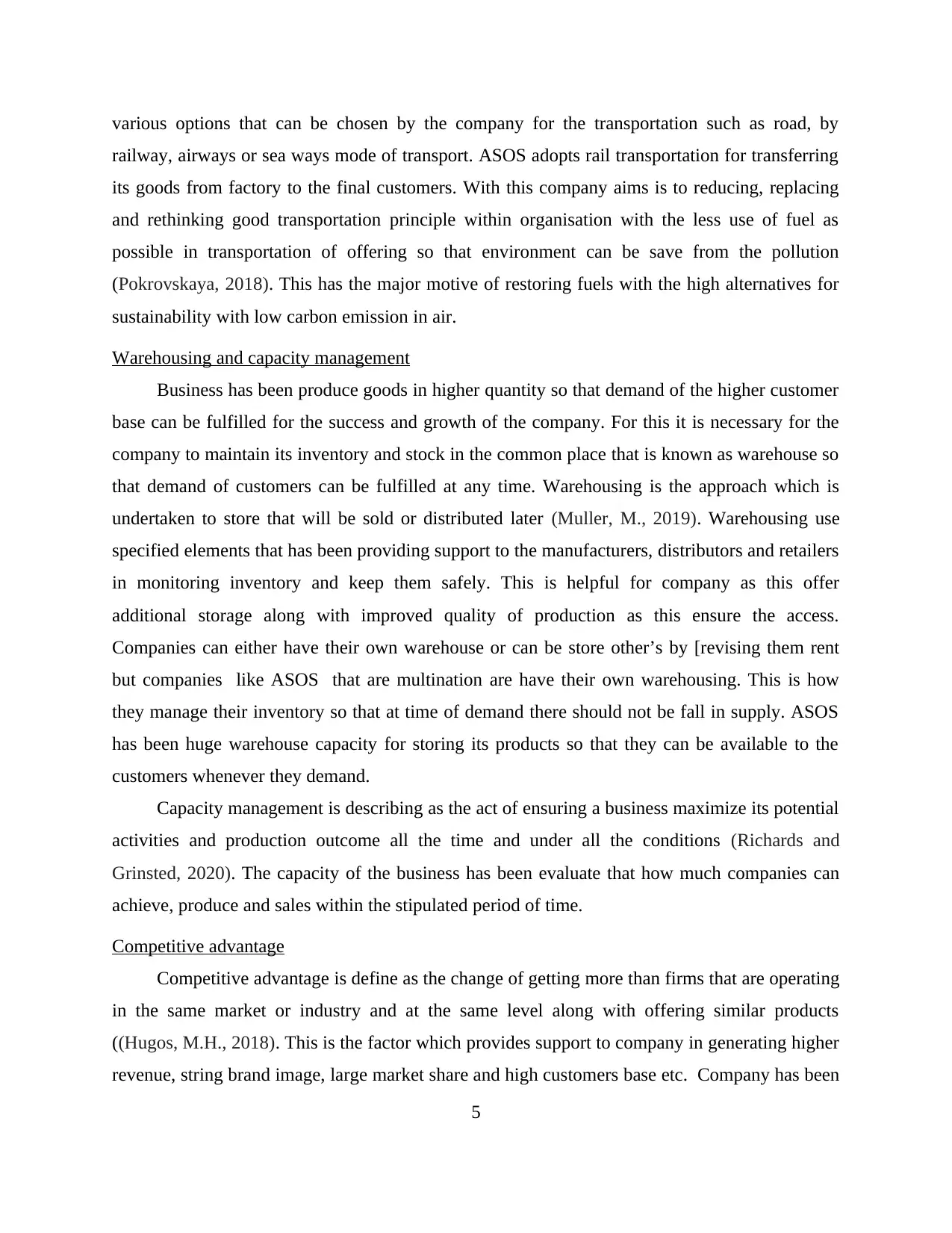
various options that can be chosen by the company for the transportation such as road, by
railway, airways or sea ways mode of transport. ASOS adopts rail transportation for transferring
its goods from factory to the final customers. With this company aims is to reducing, replacing
and rethinking good transportation principle within organisation with the less use of fuel as
possible in transportation of offering so that environment can be save from the pollution
(Pokrovskaya, 2018). This has the major motive of restoring fuels with the high alternatives for
sustainability with low carbon emission in air.
Warehousing and capacity management
Business has been produce goods in higher quantity so that demand of the higher customer
base can be fulfilled for the success and growth of the company. For this it is necessary for the
company to maintain its inventory and stock in the common place that is known as warehouse so
that demand of customers can be fulfilled at any time. Warehousing is the approach which is
undertaken to store that will be sold or distributed later (Muller, M., 2019). Warehousing use
specified elements that has been providing support to the manufacturers, distributors and retailers
in monitoring inventory and keep them safely. This is helpful for company as this offer
additional storage along with improved quality of production as this ensure the access.
Companies can either have their own warehouse or can be store other’s by [revising them rent
but companies like ASOS that are multination are have their own warehousing. This is how
they manage their inventory so that at time of demand there should not be fall in supply. ASOS
has been huge warehouse capacity for storing its products so that they can be available to the
customers whenever they demand.
Capacity management is describing as the act of ensuring a business maximize its potential
activities and production outcome all the time and under all the conditions (Richards and
Grinsted, 2020). The capacity of the business has been evaluate that how much companies can
achieve, produce and sales within the stipulated period of time.
Competitive advantage
Competitive advantage is define as the change of getting more than firms that are operating
in the same market or industry and at the same level along with offering similar products
((Hugos, M.H., 2018). This is the factor which provides support to company in generating higher
revenue, string brand image, large market share and high customers base etc. Company has been
5
railway, airways or sea ways mode of transport. ASOS adopts rail transportation for transferring
its goods from factory to the final customers. With this company aims is to reducing, replacing
and rethinking good transportation principle within organisation with the less use of fuel as
possible in transportation of offering so that environment can be save from the pollution
(Pokrovskaya, 2018). This has the major motive of restoring fuels with the high alternatives for
sustainability with low carbon emission in air.
Warehousing and capacity management
Business has been produce goods in higher quantity so that demand of the higher customer
base can be fulfilled for the success and growth of the company. For this it is necessary for the
company to maintain its inventory and stock in the common place that is known as warehouse so
that demand of customers can be fulfilled at any time. Warehousing is the approach which is
undertaken to store that will be sold or distributed later (Muller, M., 2019). Warehousing use
specified elements that has been providing support to the manufacturers, distributors and retailers
in monitoring inventory and keep them safely. This is helpful for company as this offer
additional storage along with improved quality of production as this ensure the access.
Companies can either have their own warehouse or can be store other’s by [revising them rent
but companies like ASOS that are multination are have their own warehousing. This is how
they manage their inventory so that at time of demand there should not be fall in supply. ASOS
has been huge warehouse capacity for storing its products so that they can be available to the
customers whenever they demand.
Capacity management is describing as the act of ensuring a business maximize its potential
activities and production outcome all the time and under all the conditions (Richards and
Grinsted, 2020). The capacity of the business has been evaluate that how much companies can
achieve, produce and sales within the stipulated period of time.
Competitive advantage
Competitive advantage is define as the change of getting more than firms that are operating
in the same market or industry and at the same level along with offering similar products
((Hugos, M.H., 2018). This is the factor which provides support to company in generating higher
revenue, string brand image, large market share and high customers base etc. Company has been
5
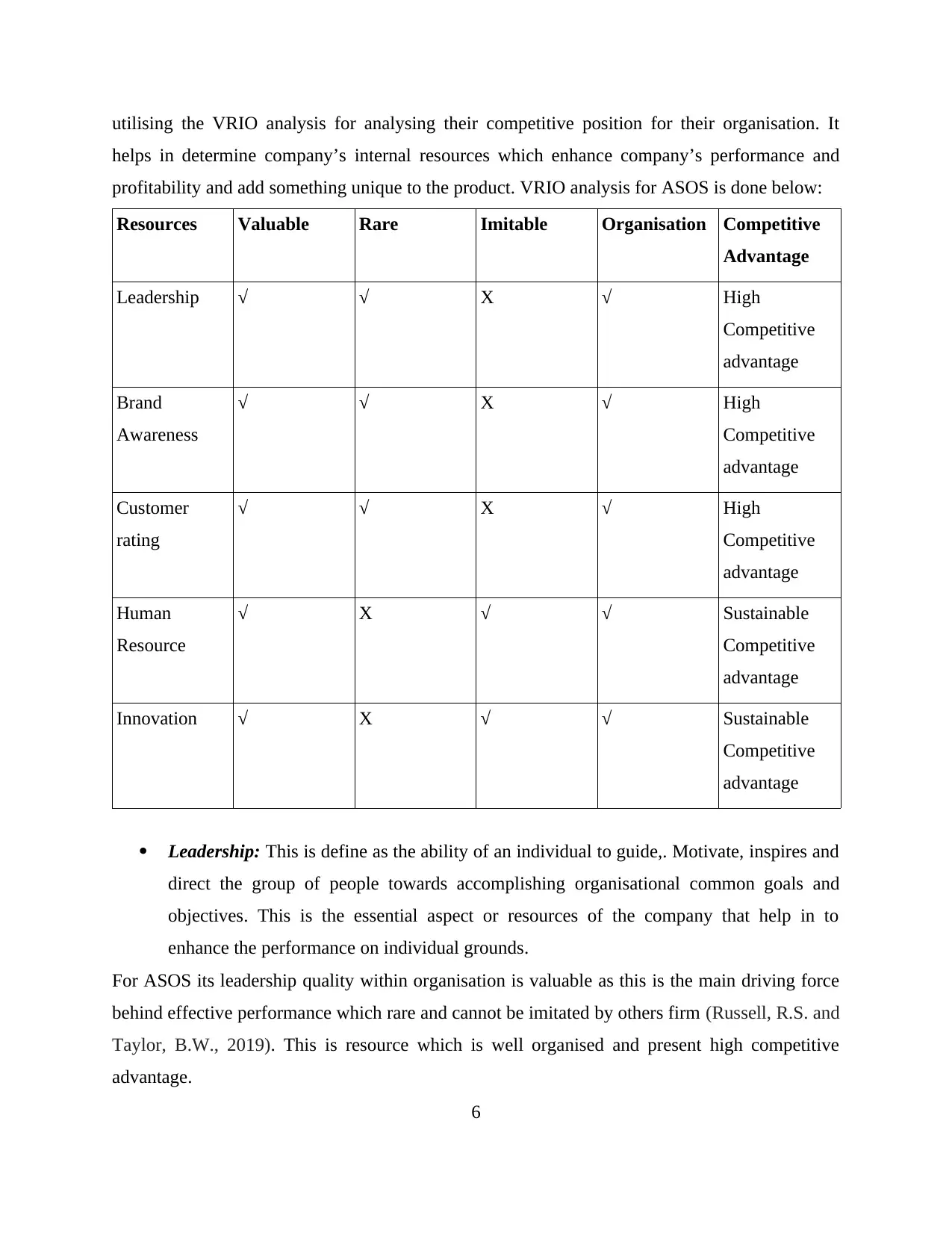
utilising the VRIO analysis for analysing their competitive position for their organisation. It
helps in determine company’s internal resources which enhance company’s performance and
profitability and add something unique to the product. VRIO analysis for ASOS is done below:
Resources Valuable Rare Imitable Organisation Competitive
Advantage
Leadership √ √ X √ High
Competitive
advantage
Brand
Awareness
√ √ X √ High
Competitive
advantage
Customer
rating
√ √ X √ High
Competitive
advantage
Human
Resource
√ X √ √ Sustainable
Competitive
advantage
Innovation √ X √ √ Sustainable
Competitive
advantage
Leadership: This is define as the ability of an individual to guide,. Motivate, inspires and
direct the group of people towards accomplishing organisational common goals and
objectives. This is the essential aspect or resources of the company that help in to
enhance the performance on individual grounds.
For ASOS its leadership quality within organisation is valuable as this is the main driving force
behind effective performance which rare and cannot be imitated by others firm (Russell, R.S. and
Taylor, B.W., 2019). This is resource which is well organised and present high competitive
advantage.
6
helps in determine company’s internal resources which enhance company’s performance and
profitability and add something unique to the product. VRIO analysis for ASOS is done below:
Resources Valuable Rare Imitable Organisation Competitive
Advantage
Leadership √ √ X √ High
Competitive
advantage
Brand
Awareness
√ √ X √ High
Competitive
advantage
Customer
rating
√ √ X √ High
Competitive
advantage
Human
Resource
√ X √ √ Sustainable
Competitive
advantage
Innovation √ X √ √ Sustainable
Competitive
advantage
Leadership: This is define as the ability of an individual to guide,. Motivate, inspires and
direct the group of people towards accomplishing organisational common goals and
objectives. This is the essential aspect or resources of the company that help in to
enhance the performance on individual grounds.
For ASOS its leadership quality within organisation is valuable as this is the main driving force
behind effective performance which rare and cannot be imitated by others firm (Russell, R.S. and
Taylor, B.W., 2019). This is resource which is well organised and present high competitive
advantage.
6
⊘ This is a preview!⊘
Do you want full access?
Subscribe today to unlock all pages.

Trusted by 1+ million students worldwide
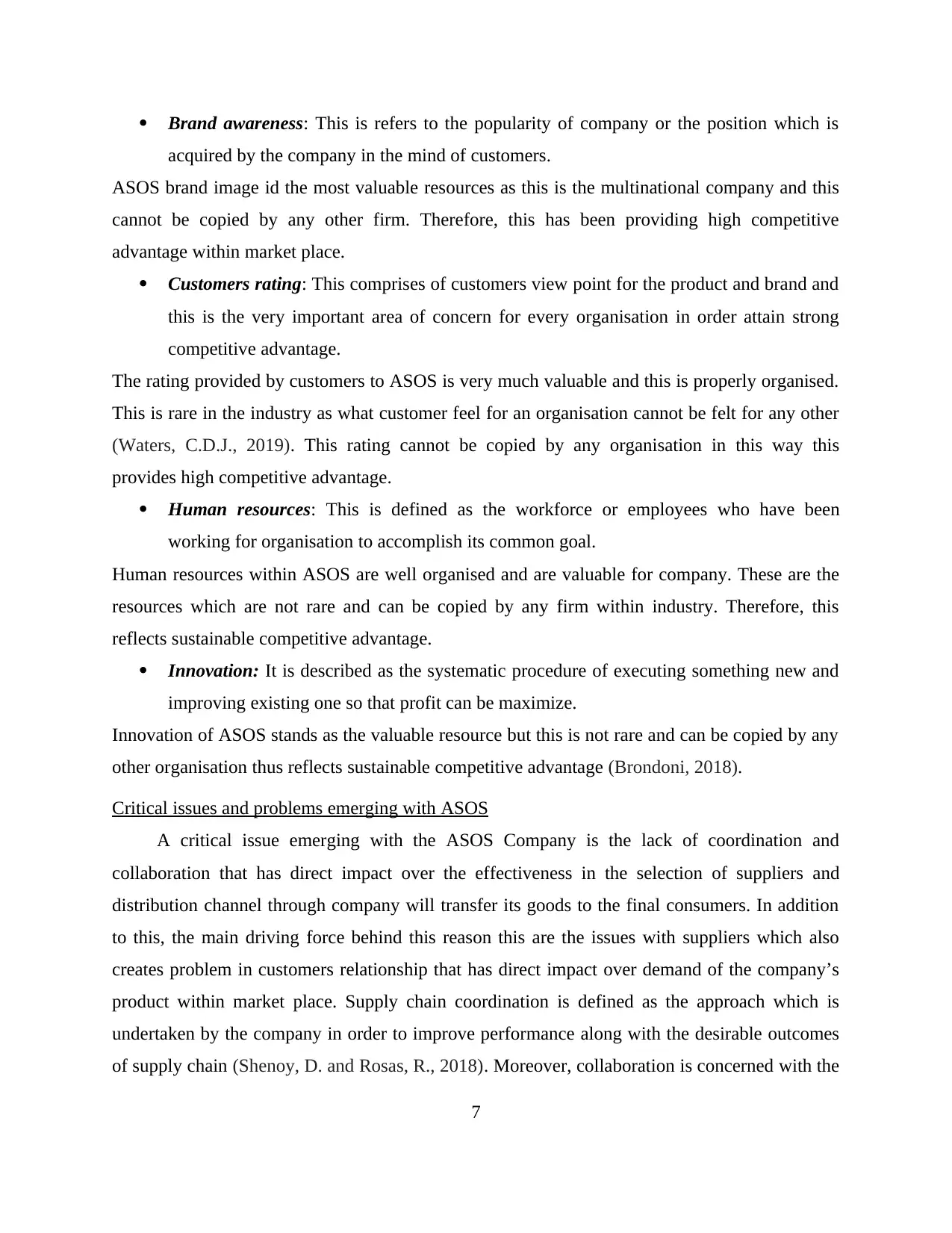
Brand awareness: This is refers to the popularity of company or the position which is
acquired by the company in the mind of customers.
ASOS brand image id the most valuable resources as this is the multinational company and this
cannot be copied by any other firm. Therefore, this has been providing high competitive
advantage within market place.
Customers rating: This comprises of customers view point for the product and brand and
this is the very important area of concern for every organisation in order attain strong
competitive advantage.
The rating provided by customers to ASOS is very much valuable and this is properly organised.
This is rare in the industry as what customer feel for an organisation cannot be felt for any other
(Waters, C.D.J., 2019). This rating cannot be copied by any organisation in this way this
provides high competitive advantage.
Human resources: This is defined as the workforce or employees who have been
working for organisation to accomplish its common goal.
Human resources within ASOS are well organised and are valuable for company. These are the
resources which are not rare and can be copied by any firm within industry. Therefore, this
reflects sustainable competitive advantage.
Innovation: It is described as the systematic procedure of executing something new and
improving existing one so that profit can be maximize.
Innovation of ASOS stands as the valuable resource but this is not rare and can be copied by any
other organisation thus reflects sustainable competitive advantage (Brondoni, 2018).
Critical issues and problems emerging with ASOS
A critical issue emerging with the ASOS Company is the lack of coordination and
collaboration that has direct impact over the effectiveness in the selection of suppliers and
distribution channel through company will transfer its goods to the final consumers. In addition
to this, the main driving force behind this reason this are the issues with suppliers which also
creates problem in customers relationship that has direct impact over demand of the company’s
product within market place. Supply chain coordination is defined as the approach which is
undertaken by the company in order to improve performance along with the desirable outcomes
of supply chain (Shenoy, D. and Rosas, R., 2018). Moreover, collaboration is concerned with the
7
acquired by the company in the mind of customers.
ASOS brand image id the most valuable resources as this is the multinational company and this
cannot be copied by any other firm. Therefore, this has been providing high competitive
advantage within market place.
Customers rating: This comprises of customers view point for the product and brand and
this is the very important area of concern for every organisation in order attain strong
competitive advantage.
The rating provided by customers to ASOS is very much valuable and this is properly organised.
This is rare in the industry as what customer feel for an organisation cannot be felt for any other
(Waters, C.D.J., 2019). This rating cannot be copied by any organisation in this way this
provides high competitive advantage.
Human resources: This is defined as the workforce or employees who have been
working for organisation to accomplish its common goal.
Human resources within ASOS are well organised and are valuable for company. These are the
resources which are not rare and can be copied by any firm within industry. Therefore, this
reflects sustainable competitive advantage.
Innovation: It is described as the systematic procedure of executing something new and
improving existing one so that profit can be maximize.
Innovation of ASOS stands as the valuable resource but this is not rare and can be copied by any
other organisation thus reflects sustainable competitive advantage (Brondoni, 2018).
Critical issues and problems emerging with ASOS
A critical issue emerging with the ASOS Company is the lack of coordination and
collaboration that has direct impact over the effectiveness in the selection of suppliers and
distribution channel through company will transfer its goods to the final consumers. In addition
to this, the main driving force behind this reason this are the issues with suppliers which also
creates problem in customers relationship that has direct impact over demand of the company’s
product within market place. Supply chain coordination is defined as the approach which is
undertaken by the company in order to improve performance along with the desirable outcomes
of supply chain (Shenoy, D. and Rosas, R., 2018). Moreover, collaboration is concerned with the
7
Paraphrase This Document
Need a fresh take? Get an instant paraphrase of this document with our AI Paraphraser
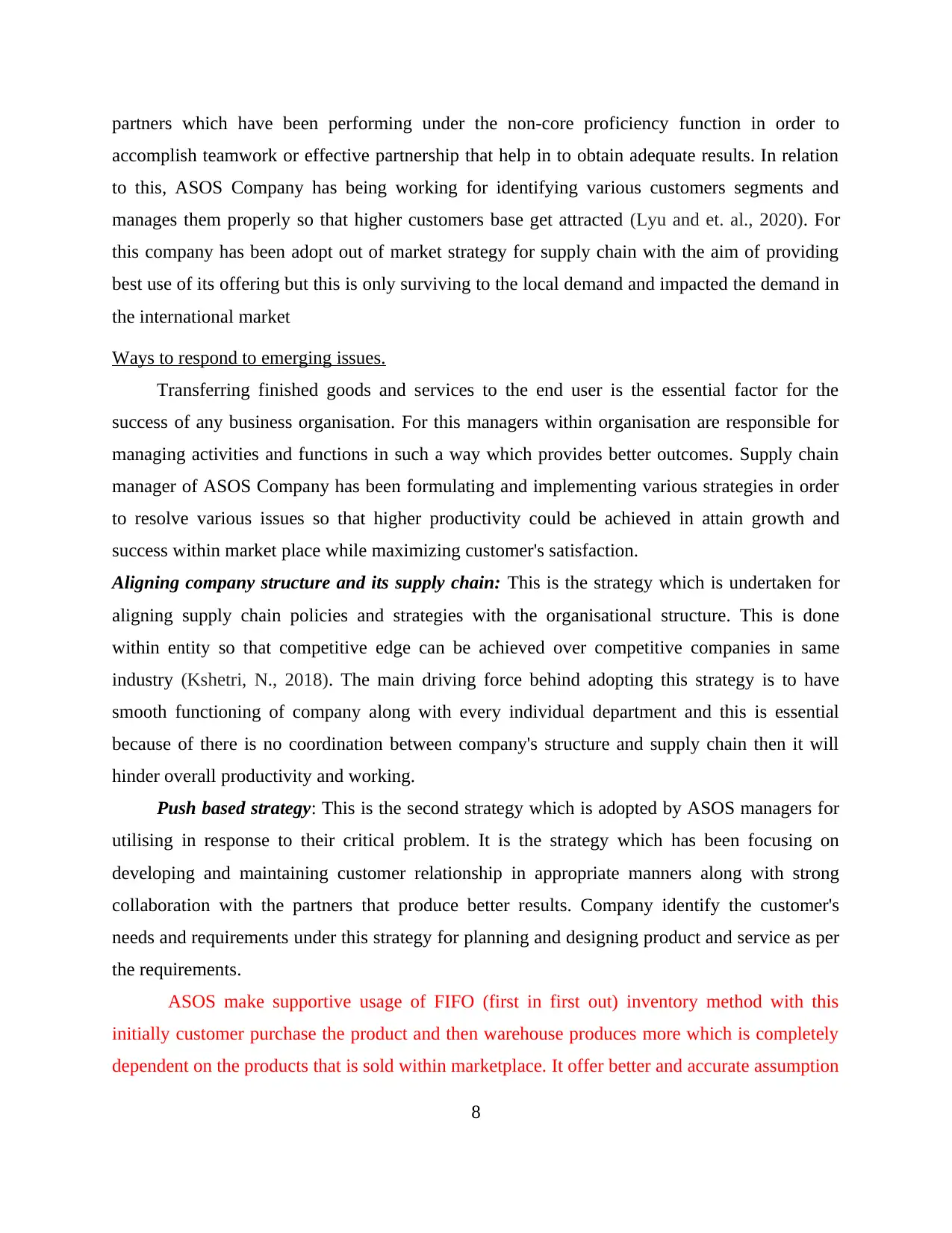
partners which have been performing under the non-core proficiency function in order to
accomplish teamwork or effective partnership that help in to obtain adequate results. In relation
to this, ASOS Company has being working for identifying various customers segments and
manages them properly so that higher customers base get attracted (Lyu and et. al., 2020). For
this company has been adopt out of market strategy for supply chain with the aim of providing
best use of its offering but this is only surviving to the local demand and impacted the demand in
the international market
Ways to respond to emerging issues.
Transferring finished goods and services to the end user is the essential factor for the
success of any business organisation. For this managers within organisation are responsible for
managing activities and functions in such a way which provides better outcomes. Supply chain
manager of ASOS Company has been formulating and implementing various strategies in order
to resolve various issues so that higher productivity could be achieved in attain growth and
success within market place while maximizing customer's satisfaction.
Aligning company structure and its supply chain: This is the strategy which is undertaken for
aligning supply chain policies and strategies with the organisational structure. This is done
within entity so that competitive edge can be achieved over competitive companies in same
industry (Kshetri, N., 2018). The main driving force behind adopting this strategy is to have
smooth functioning of company along with every individual department and this is essential
because of there is no coordination between company's structure and supply chain then it will
hinder overall productivity and working.
Push based strategy: This is the second strategy which is adopted by ASOS managers for
utilising in response to their critical problem. It is the strategy which has been focusing on
developing and maintaining customer relationship in appropriate manners along with strong
collaboration with the partners that produce better results. Company identify the customer's
needs and requirements under this strategy for planning and designing product and service as per
the requirements.
ASOS make supportive usage of FIFO (first in first out) inventory method with this
initially customer purchase the product and then warehouse produces more which is completely
dependent on the products that is sold within marketplace. It offer better and accurate assumption
8
accomplish teamwork or effective partnership that help in to obtain adequate results. In relation
to this, ASOS Company has being working for identifying various customers segments and
manages them properly so that higher customers base get attracted (Lyu and et. al., 2020). For
this company has been adopt out of market strategy for supply chain with the aim of providing
best use of its offering but this is only surviving to the local demand and impacted the demand in
the international market
Ways to respond to emerging issues.
Transferring finished goods and services to the end user is the essential factor for the
success of any business organisation. For this managers within organisation are responsible for
managing activities and functions in such a way which provides better outcomes. Supply chain
manager of ASOS Company has been formulating and implementing various strategies in order
to resolve various issues so that higher productivity could be achieved in attain growth and
success within market place while maximizing customer's satisfaction.
Aligning company structure and its supply chain: This is the strategy which is undertaken for
aligning supply chain policies and strategies with the organisational structure. This is done
within entity so that competitive edge can be achieved over competitive companies in same
industry (Kshetri, N., 2018). The main driving force behind adopting this strategy is to have
smooth functioning of company along with every individual department and this is essential
because of there is no coordination between company's structure and supply chain then it will
hinder overall productivity and working.
Push based strategy: This is the second strategy which is adopted by ASOS managers for
utilising in response to their critical problem. It is the strategy which has been focusing on
developing and maintaining customer relationship in appropriate manners along with strong
collaboration with the partners that produce better results. Company identify the customer's
needs and requirements under this strategy for planning and designing product and service as per
the requirements.
ASOS make supportive usage of FIFO (first in first out) inventory method with this
initially customer purchase the product and then warehouse produces more which is completely
dependent on the products that is sold within marketplace. It offer better and accurate assumption
8
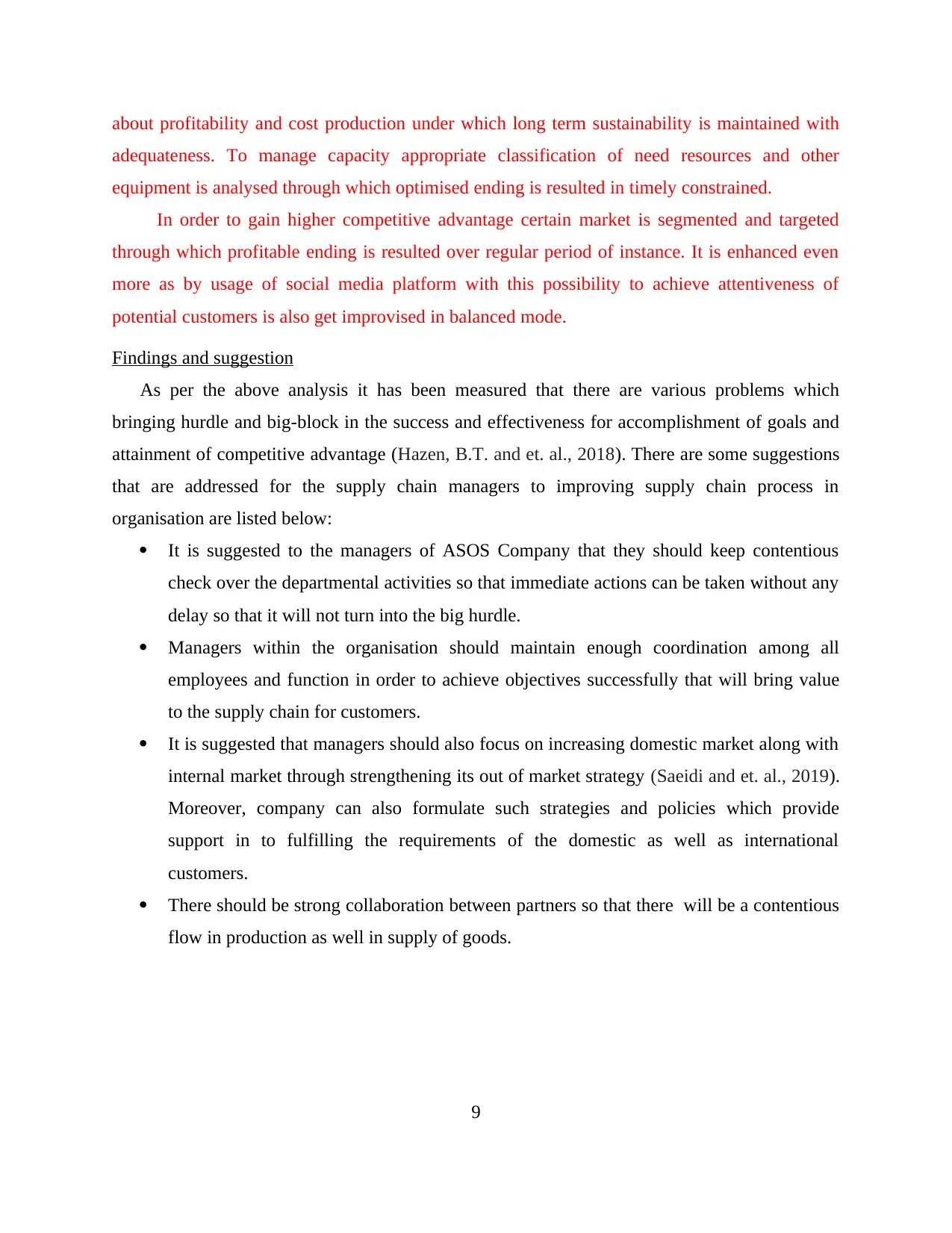
about profitability and cost production under which long term sustainability is maintained with
adequateness. To manage capacity appropriate classification of need resources and other
equipment is analysed through which optimised ending is resulted in timely constrained.
In order to gain higher competitive advantage certain market is segmented and targeted
through which profitable ending is resulted over regular period of instance. It is enhanced even
more as by usage of social media platform with this possibility to achieve attentiveness of
potential customers is also get improvised in balanced mode.
Findings and suggestion
As per the above analysis it has been measured that there are various problems which
bringing hurdle and big-block in the success and effectiveness for accomplishment of goals and
attainment of competitive advantage (Hazen, B.T. and et. al., 2018). There are some suggestions
that are addressed for the supply chain managers to improving supply chain process in
organisation are listed below:
It is suggested to the managers of ASOS Company that they should keep contentious
check over the departmental activities so that immediate actions can be taken without any
delay so that it will not turn into the big hurdle.
Managers within the organisation should maintain enough coordination among all
employees and function in order to achieve objectives successfully that will bring value
to the supply chain for customers.
It is suggested that managers should also focus on increasing domestic market along with
internal market through strengthening its out of market strategy (Saeidi and et. al., 2019).
Moreover, company can also formulate such strategies and policies which provide
support in to fulfilling the requirements of the domestic as well as international
customers.
There should be strong collaboration between partners so that there will be a contentious
flow in production as well in supply of goods.
9
adequateness. To manage capacity appropriate classification of need resources and other
equipment is analysed through which optimised ending is resulted in timely constrained.
In order to gain higher competitive advantage certain market is segmented and targeted
through which profitable ending is resulted over regular period of instance. It is enhanced even
more as by usage of social media platform with this possibility to achieve attentiveness of
potential customers is also get improvised in balanced mode.
Findings and suggestion
As per the above analysis it has been measured that there are various problems which
bringing hurdle and big-block in the success and effectiveness for accomplishment of goals and
attainment of competitive advantage (Hazen, B.T. and et. al., 2018). There are some suggestions
that are addressed for the supply chain managers to improving supply chain process in
organisation are listed below:
It is suggested to the managers of ASOS Company that they should keep contentious
check over the departmental activities so that immediate actions can be taken without any
delay so that it will not turn into the big hurdle.
Managers within the organisation should maintain enough coordination among all
employees and function in order to achieve objectives successfully that will bring value
to the supply chain for customers.
It is suggested that managers should also focus on increasing domestic market along with
internal market through strengthening its out of market strategy (Saeidi and et. al., 2019).
Moreover, company can also formulate such strategies and policies which provide
support in to fulfilling the requirements of the domestic as well as international
customers.
There should be strong collaboration between partners so that there will be a contentious
flow in production as well in supply of goods.
9
⊘ This is a preview!⊘
Do you want full access?
Subscribe today to unlock all pages.

Trusted by 1+ million students worldwide
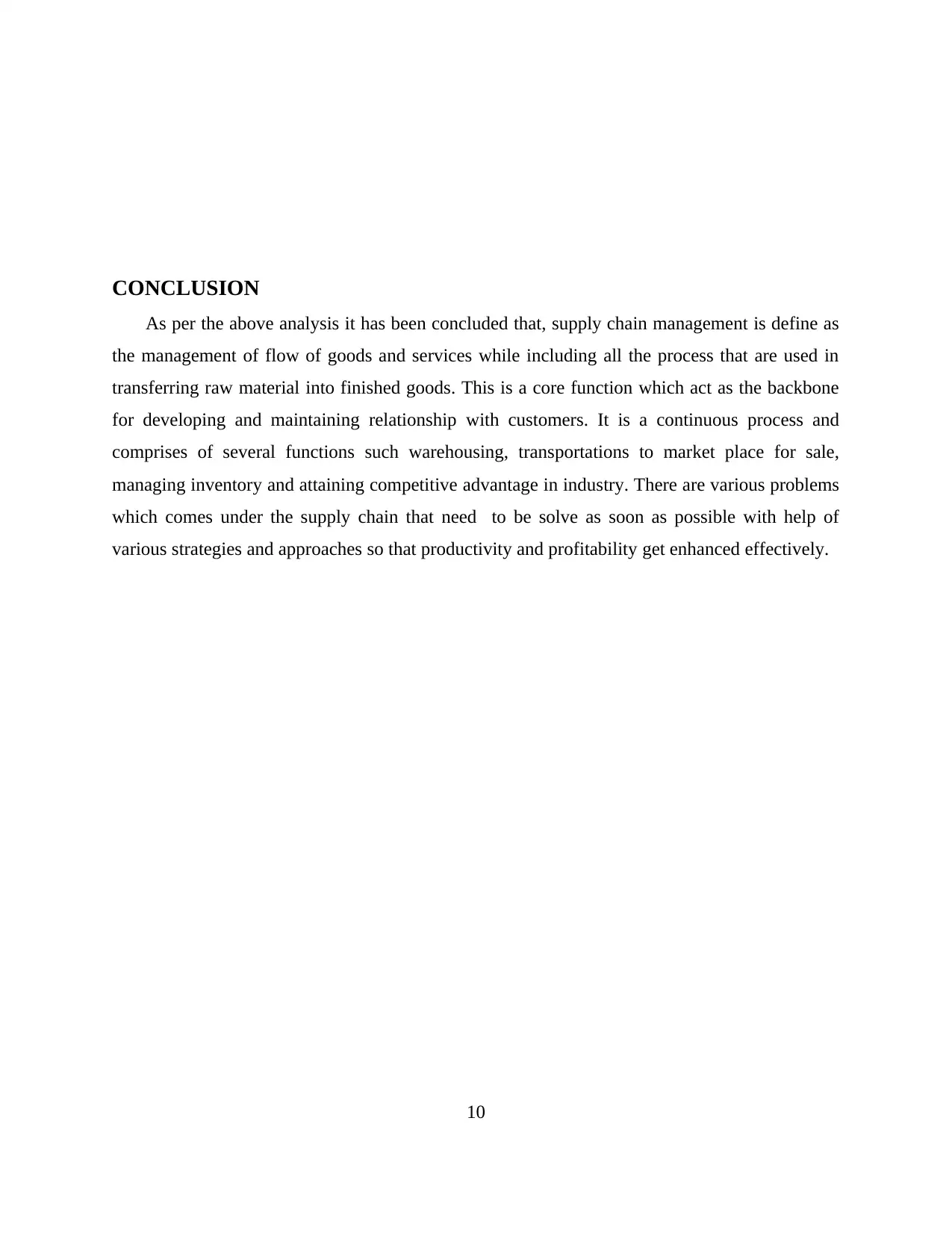
CONCLUSION
As per the above analysis it has been concluded that, supply chain management is define as
the management of flow of goods and services while including all the process that are used in
transferring raw material into finished goods. This is a core function which act as the backbone
for developing and maintaining relationship with customers. It is a continuous process and
comprises of several functions such warehousing, transportations to market place for sale,
managing inventory and attaining competitive advantage in industry. There are various problems
which comes under the supply chain that need to be solve as soon as possible with help of
various strategies and approaches so that productivity and profitability get enhanced effectively.
10
As per the above analysis it has been concluded that, supply chain management is define as
the management of flow of goods and services while including all the process that are used in
transferring raw material into finished goods. This is a core function which act as the backbone
for developing and maintaining relationship with customers. It is a continuous process and
comprises of several functions such warehousing, transportations to market place for sale,
managing inventory and attaining competitive advantage in industry. There are various problems
which comes under the supply chain that need to be solve as soon as possible with help of
various strategies and approaches so that productivity and profitability get enhanced effectively.
10
Paraphrase This Document
Need a fresh take? Get an instant paraphrase of this document with our AI Paraphraser
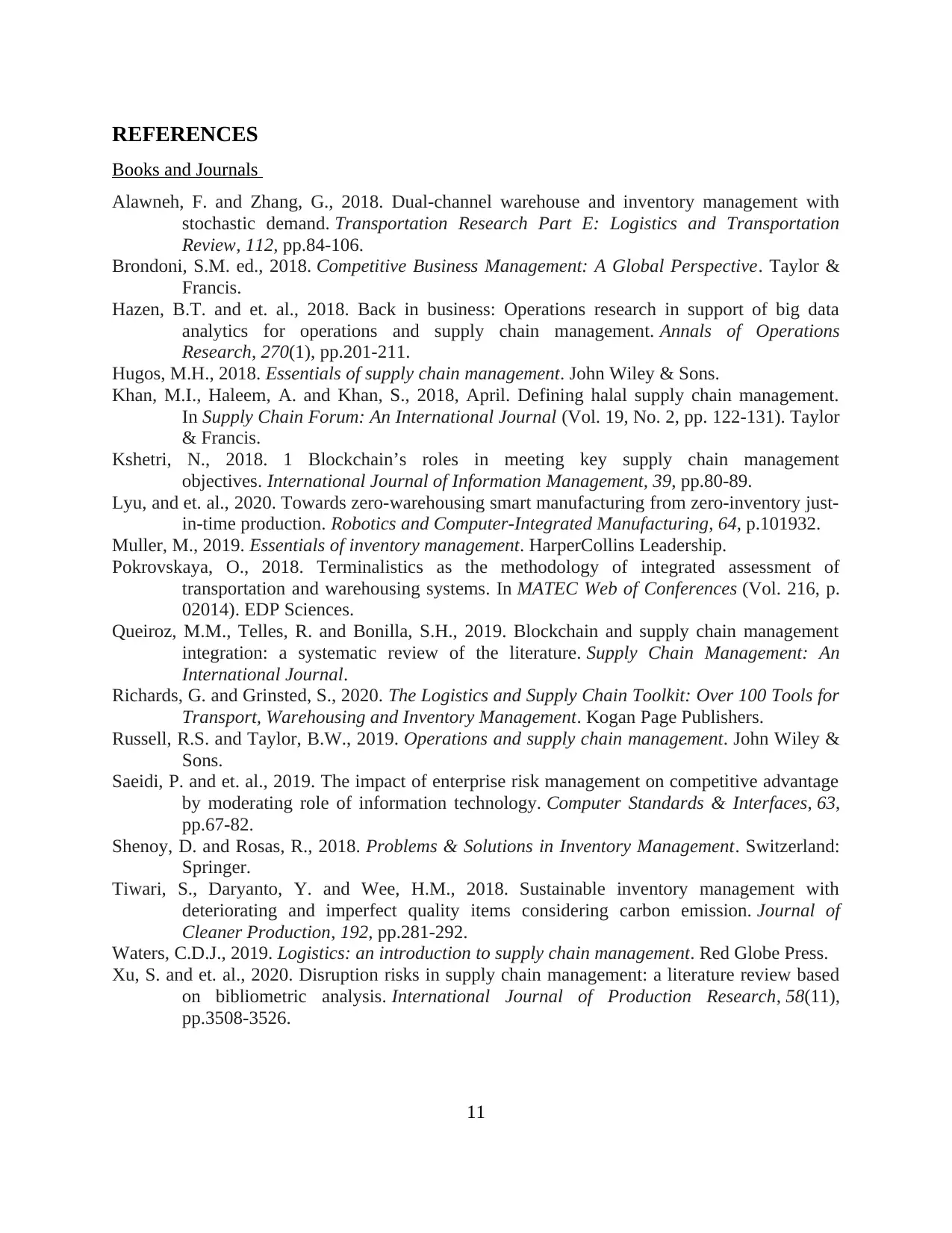
REFERENCES
Books and Journals
Alawneh, F. and Zhang, G., 2018. Dual-channel warehouse and inventory management with
stochastic demand. Transportation Research Part E: Logistics and Transportation
Review, 112, pp.84-106.
Brondoni, S.M. ed., 2018. Competitive Business Management: A Global Perspective. Taylor &
Francis.
Hazen, B.T. and et. al., 2018. Back in business: Operations research in support of big data
analytics for operations and supply chain management. Annals of Operations
Research, 270(1), pp.201-211.
Hugos, M.H., 2018. Essentials of supply chain management. John Wiley & Sons.
Khan, M.I., Haleem, A. and Khan, S., 2018, April. Defining halal supply chain management.
In Supply Chain Forum: An International Journal (Vol. 19, No. 2, pp. 122-131). Taylor
& Francis.
Kshetri, N., 2018. 1 Blockchain’s roles in meeting key supply chain management
objectives. International Journal of Information Management, 39, pp.80-89.
Lyu, and et. al., 2020. Towards zero-warehousing smart manufacturing from zero-inventory just-
in-time production. Robotics and Computer-Integrated Manufacturing, 64, p.101932.
Muller, M., 2019. Essentials of inventory management. HarperCollins Leadership.
Pokrovskaya, O., 2018. Terminalistics as the methodology of integrated assessment of
transportation and warehousing systems. In MATEC Web of Conferences (Vol. 216, p.
02014). EDP Sciences.
Queiroz, M.M., Telles, R. and Bonilla, S.H., 2019. Blockchain and supply chain management
integration: a systematic review of the literature. Supply Chain Management: An
International Journal.
Richards, G. and Grinsted, S., 2020. The Logistics and Supply Chain Toolkit: Over 100 Tools for
Transport, Warehousing and Inventory Management. Kogan Page Publishers.
Russell, R.S. and Taylor, B.W., 2019. Operations and supply chain management. John Wiley &
Sons.
Saeidi, P. and et. al., 2019. The impact of enterprise risk management on competitive advantage
by moderating role of information technology. Computer Standards & Interfaces, 63,
pp.67-82.
Shenoy, D. and Rosas, R., 2018. Problems & Solutions in Inventory Management. Switzerland:
Springer.
Tiwari, S., Daryanto, Y. and Wee, H.M., 2018. Sustainable inventory management with
deteriorating and imperfect quality items considering carbon emission. Journal of
Cleaner Production, 192, pp.281-292.
Waters, C.D.J., 2019. Logistics: an introduction to supply chain management. Red Globe Press.
Xu, S. and et. al., 2020. Disruption risks in supply chain management: a literature review based
on bibliometric analysis. International Journal of Production Research, 58(11),
pp.3508-3526.
11
Books and Journals
Alawneh, F. and Zhang, G., 2018. Dual-channel warehouse and inventory management with
stochastic demand. Transportation Research Part E: Logistics and Transportation
Review, 112, pp.84-106.
Brondoni, S.M. ed., 2018. Competitive Business Management: A Global Perspective. Taylor &
Francis.
Hazen, B.T. and et. al., 2018. Back in business: Operations research in support of big data
analytics for operations and supply chain management. Annals of Operations
Research, 270(1), pp.201-211.
Hugos, M.H., 2018. Essentials of supply chain management. John Wiley & Sons.
Khan, M.I., Haleem, A. and Khan, S., 2018, April. Defining halal supply chain management.
In Supply Chain Forum: An International Journal (Vol. 19, No. 2, pp. 122-131). Taylor
& Francis.
Kshetri, N., 2018. 1 Blockchain’s roles in meeting key supply chain management
objectives. International Journal of Information Management, 39, pp.80-89.
Lyu, and et. al., 2020. Towards zero-warehousing smart manufacturing from zero-inventory just-
in-time production. Robotics and Computer-Integrated Manufacturing, 64, p.101932.
Muller, M., 2019. Essentials of inventory management. HarperCollins Leadership.
Pokrovskaya, O., 2018. Terminalistics as the methodology of integrated assessment of
transportation and warehousing systems. In MATEC Web of Conferences (Vol. 216, p.
02014). EDP Sciences.
Queiroz, M.M., Telles, R. and Bonilla, S.H., 2019. Blockchain and supply chain management
integration: a systematic review of the literature. Supply Chain Management: An
International Journal.
Richards, G. and Grinsted, S., 2020. The Logistics and Supply Chain Toolkit: Over 100 Tools for
Transport, Warehousing and Inventory Management. Kogan Page Publishers.
Russell, R.S. and Taylor, B.W., 2019. Operations and supply chain management. John Wiley &
Sons.
Saeidi, P. and et. al., 2019. The impact of enterprise risk management on competitive advantage
by moderating role of information technology. Computer Standards & Interfaces, 63,
pp.67-82.
Shenoy, D. and Rosas, R., 2018. Problems & Solutions in Inventory Management. Switzerland:
Springer.
Tiwari, S., Daryanto, Y. and Wee, H.M., 2018. Sustainable inventory management with
deteriorating and imperfect quality items considering carbon emission. Journal of
Cleaner Production, 192, pp.281-292.
Waters, C.D.J., 2019. Logistics: an introduction to supply chain management. Red Globe Press.
Xu, S. and et. al., 2020. Disruption risks in supply chain management: a literature review based
on bibliometric analysis. International Journal of Production Research, 58(11),
pp.3508-3526.
11
1 out of 11
Related Documents
Your All-in-One AI-Powered Toolkit for Academic Success.
+13062052269
info@desklib.com
Available 24*7 on WhatsApp / Email
![[object Object]](/_next/static/media/star-bottom.7253800d.svg)
Unlock your academic potential
Copyright © 2020–2025 A2Z Services. All Rights Reserved. Developed and managed by ZUCOL.





